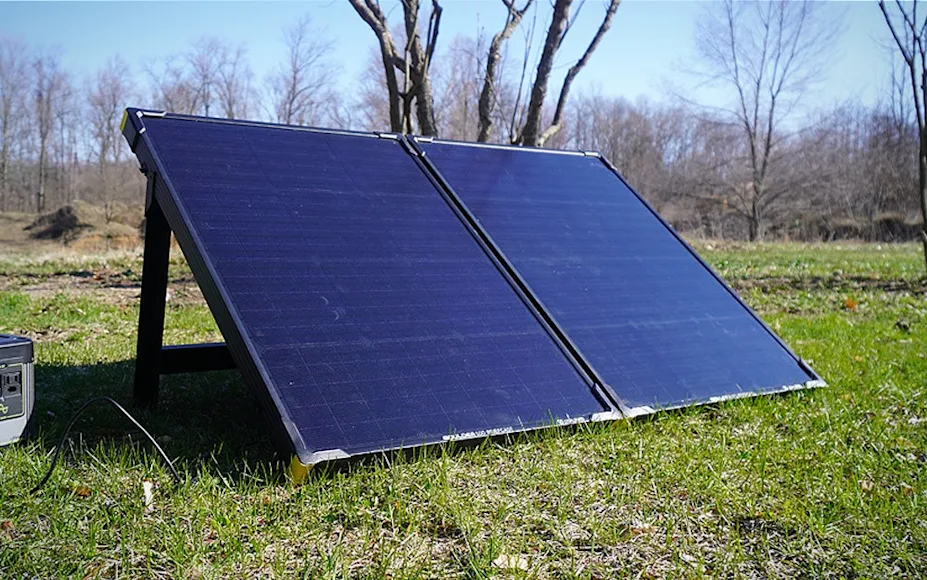_We may earn revenue from the products available on this page and participate in affiliate programs. Learn more ›
_
Best Overall

Goal Zero Boulder Briefcase
LEARN MORE
Summary
The Goal Zero’s ultra heavy-duty build feels like a throwback to a lost era when companies actually built products to last a lifetime.
Pros
Very durable
Ergonomic carry handle
Protective case included
Cons
Heavy
Other panels have better input
Best Lightweight
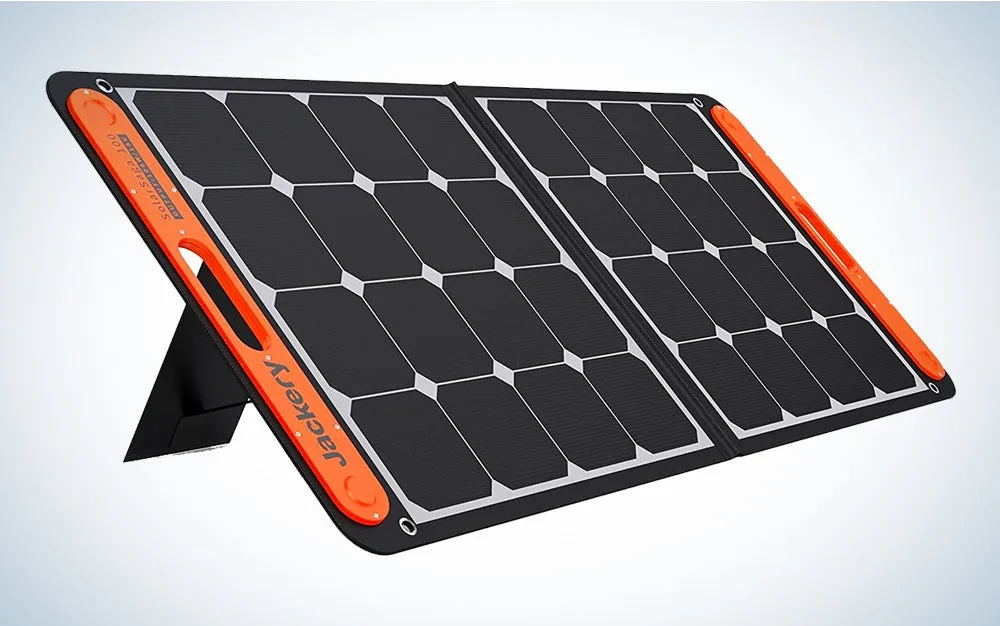
Jackery Solar Saga
LEARN MORE
Summary
Jackery managed to cut the weight and profile of a standard 100-watt portable solar panel significantly over their competitors.
Pros
Extremely light for a foldable
Charges solar generators and phones directly
Magnetic closing is incredibly simple
Cons
Pricey
Not entirely waterproof
Best Value

Topsolar Solar Fairy
LEARN MORE
Summary
The Solar Fairy is more compact than just about every similar wattage panel currently on the market today and features a bevy of accessories other companies sell separately.
Pros
Light with an easy carry case
Folds to compact size
Multiple power ports
Cons
Doesn’t work with Goal Zero products
The best portable solar panels provide a clean renewable energy resource even when off the grid far from civilization. Manufacturers are now offering more panels in many different sizes, wattages, and configurations to fit any budget and case use scenario. The only difficult part is choosing the correct solar panel for the task at hand.
We are here to help you narrow down which one is right for you with a variety of selections based on best uses and budgetary restrictions. These are the best portable solar panels being made today.
Best Overall: Goal Zero Boulder Briefcase
Best Value: Topsolar Solar Fairy
Best Lightweight: Jackery Solar Saga
Best Budget: Flexsolar Solar Charger
Best for RVs: Bouge RV 9BB
Best for Phones: Renogy 21-Watt Foldable
Best with Battery Included: Tranmix Solar Charger
Best Portable Folding: Bluetti PV 120
How We Picked the Best Portable Solar Panels
I have personally tested some of the panels on this list because I usually utilize solar to keep my electronics powered while working remotely on a laptop from my vehicle. Consequently, I have learned a lot about how solar technology works and the types of panels that work best. Aside from personal experience, I also considered the following factors for picking the top portable panels.
Weight: Is this panel light enough to take in a backpack into the backcountry? Is the panel better suited for power outages at home, or for use with an RV?
Wattage: What’s the maximum rating for this panel? Is it best suited for charging a cell phone or for larger electronics like a portable fridge?
Construction: Is this panel durable enough for travel? What materials were used for the frame?
Best Portable Solar Panels: Reviews and Recommendations
Best Overall: Goal Zero Boulder Briefcase
Best Overall

Specs
Rated Wattage: 100, 200, and 300 watts
Dimensions: 26” x 43” x 1.75”
Weight: 25.9 pounds
Construction: Tempered glass and aluminum
Pros
Very durable
Ergonomic carry handles
Protective case included
Cons
Heavy
Other panels have better input
I’ve owned the Goal Zero Boulder Briefcase 100 for about a year now and it has become my go-to panel for most situations. This is one of the toughest panels on the market thanks to the aluminum and tempered glass construction. I’ve slammed this panel in car doors and accidentally dropped it onto pavement without a single scratch. This is the panel to buy for anyone who is hard on their equipment. It’s a shame more companies don’t build products like this anymore because everything from the folding legs to the heavy-duty carry handle just feels beefy and well-made.
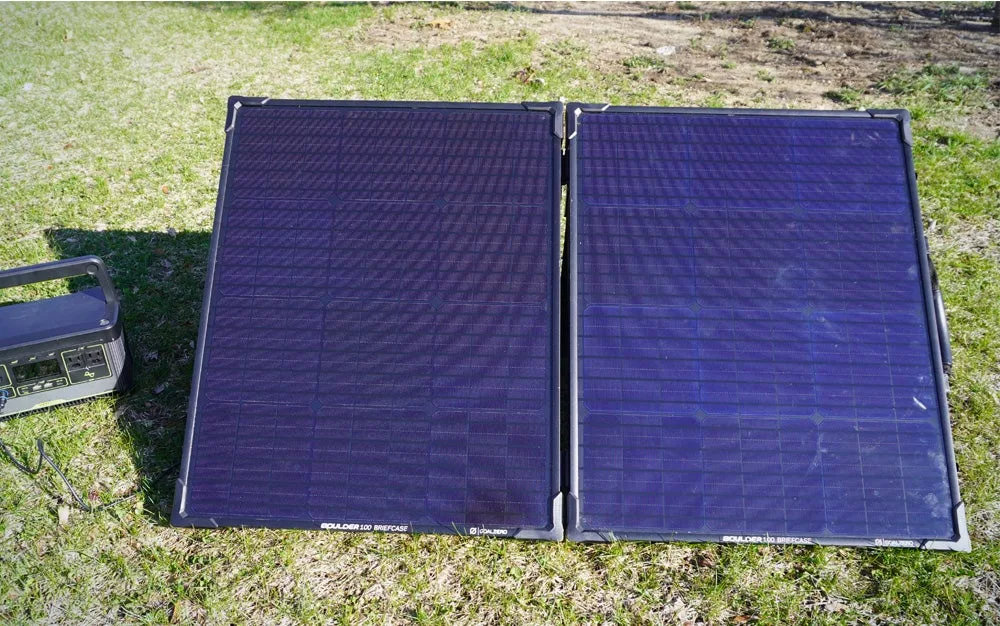
Goal Zero’s Boulder Briefcase features a rather rugged build not found with other panels. Photo by Travis Smola
This panel is rather heavy, but my main complaint is that it’s not as efficient as others I’ve tested. The 100-Watt Goal Zero draws about 55 to 65 watts consistently on a clear day here in Michigan while my 100-Watt Bouge RV regularly pulls in 70+ comparatively. However, at least for me, the durability of the build is worth the small trade-off in efficiency.
Best Lightweight: Jackery Solar Saga
Best Lightweight

Specs
Rated Wattage: 60, 100, 200 watts
Dimensions (100-Watt): 22.83” x 19.69” x 2.36”
Weight (100-Watt): 10.33 pounds
Construction: Monocrystalline silicon
Pros
Extremely light for a foldable
Charges solar generators and phones directly
Magnetic closing is incredibly simple
Cons
Price
Not entirely weatherproof
Jackery offers this portable solar panel in a few different wattages, but it’s hard to beat the 10.33-pound weight for the 100-watt folding offering. This panel is almost 15 pounds lighter than the Goal Zero Boulder Briefcase, making it a breeze to carry around and stow in a camper or SUV until you need it. Jackery is also one of the few companies putting a USB port on a panel of this size for charging a cellphone directly. While most users are going to use this panel directly with a portable solar generator
, it’s nice to have the capability to power up small electronics individually too. We also like the slim profile which makes this panel easier to stow away in tight spaces in a camper or boat than the competitors.
The $300 price tag is a little on the high side for this panel, but user reviews rave
about the effectiveness and durability of these panels. Subsequently, this is our recommendation for anyone concerned about saving space with a portable panel.
Best Value: Topsolar Solar Fairy
Best Value

Specs
Rated Wattage: 100 and 60 watts
Dimensions (100 Watt): 22.83” x 17.72” x 2.95”
Weight: 5.10 pounds
Construction: Fabric and monocrystalline
Pros
Light with an easy carry case
Folds to a compact size
Multiple power ports
Cons
Doesn’t work with Goal Zero products
The Solar Fairy folds down to a rather compact 11- x 8-inch package that makes it a breeze to transport from place to place. Combine that with a 5-pound weight and this panel will easily stow behind a truck seat or in an RV storage compartment until you need it most. The value in this panel comes from the variety of output ports that that make connecting to a battery or portable power station easy. There is also a USB port for direct charging of a cell phone.
One big downside to this panel is that it is not compatible with Goal Zero products such as their power banks and power stations, so if you already own one of their products, this won’t work. It’s also not quite as durable due to the lightweight materials. However, this panel will work with other popular brands such as Jackery.
Best Budget: Flexsolar Solar Charger
Best Budget
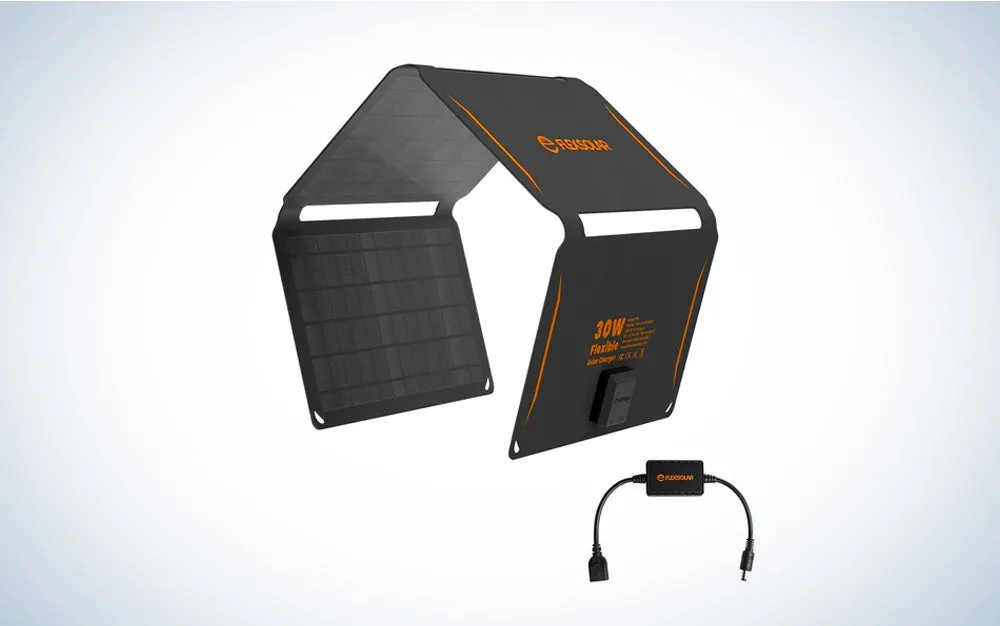
Specs
Rated Wattages: 10, 15, 20, 30 and 40 watts
Dimensions (30-Watt): 32” x 12”
Weight: 31.7 ounces
Construction: Monocystalline
Pros
Excellent price point
Included DC to USB converter
Rugged build
Cons
Slow charging
Flexsolar builds five different wattage variants of this solar charger with the cheapest starting at only $30. These simple panels are designed primarily to power up smart phones, tablets, and other small devices like cameras. This is a good option for campers who like to boondock and use primitive camping sites. However, we also like this option for anyone who wants something simple in case of natural disaster or power outage. These panels are also rigid rather than connected with a nylon fabric like their competitors, which makes them slightly more durable.
The downside to these chargers is that multiple user reviews online note that while the panel is effective, it takes some time to fully charge devices. Other reviews note it has issues with cloud cover. Because the panel needs direct sunlight for extended periods, it may not be the best for hikers on the move. However, as an emergency item, this is a small investment that can keep you connected when the grid goes down.
Best for RVs: Bouge RV 9BB
Best for RVs
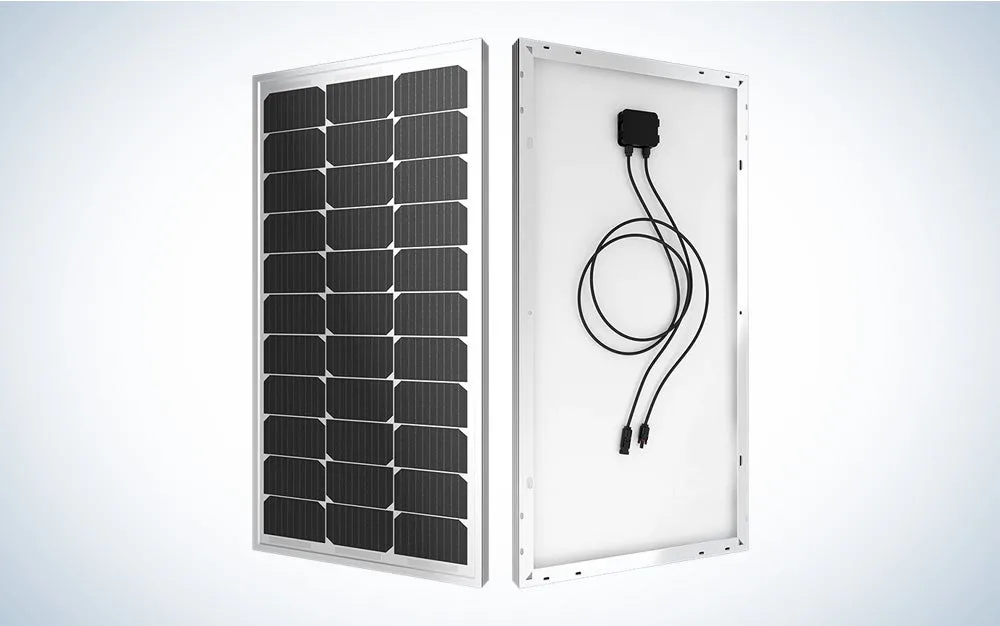
Specs
Rated Wattage: 100, 180, and 200 watts
Dimensions (100 Watt): 39” x 21” x 1.38”
Weight: 16.97 pounds
Construction: Aluminum
Pros
Affordable
Great conversion rate
All-weather design
Cons
Not packaged well from factory
Most campers are going to permanently mount their panels to their rig, and the Bouge RV perfectly fits that bill. It would be rather easy to add some folding legs to this panel, or to fashion two of them into a briefcase style solar system saving a ton of money. I mounted this panel permanently to the top of my van conversion build and it has impressed me with its efficiency. During my testing, I consistently got 65 to 70 watts of input on a cloudless day.

The Bouge RV mounts nicely to a van or RV, but is light and versatile enough for other uses. Photo by Travis Smola
Bouge RV skimps a bit on packaging, which is probably one reason why these panels have such a great price point. Some online reviews mention their panels arriving with dents and dings. However, I had no issues with the two panels I’ve ordered from this company. This panel is also a good choice for a remote hunting cabin or backwoods cottage. I have subjected this panel to rain, and even snow here in Michigan with no issues.
Best for Phones: Renogy 21 Watt Foldable
Best for Phones

Specs
Rated Wattage: 21 watts
Dimensions: 23” x 11” x 0.8”
Weight: 28.9 ounces
Construction: Nylon
Pros
Charges phones and small devices quickly
Light enough for backpacking
Cons
Price
Weighing in at just under two pounds, the Renogy 21-watt foldable is perfect for simple charging of cell phones and other small devices. This panel has two USB ports for charging up to two devices at once. Most user reviews report good success charging up a phone or small power bank in only a few hours. Most user reviews also note the nylon material holds up nicely to abuse. Additionally, Renogy includes two carabiners for attaching to a backpack for mobile charging while hiking.
The only real downside is that the $69.99 price tag feels a little high for a panel of this wattage. We also wish this panel was waterproof instead of water-resistant. Subsequently, this panel cannot be left outside in rain or snow.
Best with Battery Included: Tranmix Solar Charger
Best with Battery Included

Specs
Rated Wattage: 6 watts
Dimensions: 6.1” x 3.3” x 1.37”
Weight: 1.18 pounds
Construction: Plastic
Pros
25000 mAh power bank included
Highly affordable
Compact design
Cons
Reported durability issues
Limited to small electronics
The Tranmix portable solar panel only has a six-watt capacity, but it also comes with a 25000-milliamp hour battery included standard that allows charging of devices well after the sun goes down. This simple panel is incredibly compact and weighs just 1.18 pounds, which makes it easy for thru-hikers and backcountry campers to haul. Additionally, the cheap $45 price tag is hard to beat. Tranmix also includes an LED light which just adds to the functionality of this device.
However, this panel does have a downside. Durability issues are a commonly reported problem in Amazon reviews, specifically issues with the case cracking slightly. This may not be the best option for anyone who is rough on their equipment.
Best Portable Folding: Bluetti PV 120
Best Portable Folding

Specs
Rated Wattage: 120 watts
Dimensions: 21” x 65”
Weight: 12.75 pounds
Construction: Monocrystalline silicon
Pros
Light
Highly efficient
9-foot cable is standard
Cons
Price tag
Not waterproof
Bluetti’s PV120 panel folds down to just 21 x 18.5 inches, making it an excellent option for car campers or overlanders who need a quick charging solution off the grid. It’s also a great option to tuck into a closet for powering a solar generator in a power outage. This panel pairs nicely with many of Bluetti’s power stations and user reviews note how this panel regularly delivers 90 to 100 watts, making it a highly efficient option.
This panel comes packaged with an IP67 junction box, but unfortunately, this panel is not waterproof. Bluetti also strongly discourages exposure to snow. For the price point, it’s disappointing this panel is not more weather-resistant. However, if you don’t need to leave the panel out overnight, this is a solid option for power station owners.
What to Consider When Choosing a Portable Solar Panel
With portable solar panels, it’s important to remember that in most cases the panels do not power electrical devices directly. Solar panels convert the light of the sun into energy. This energy is stowed in a battery or solar generator
. Other panels are designed for charging cell phones and other small electrical devices directly. However, these panels are seldom more than 15 to 20 watts.
Obviously, the more electronics you plan to use, the more wattage you’ll need. That means a larger panel and battery to stow all that energy. In my experience, an 1,100-watt hour power station combined with a 100-watt solar panel keeps my Dometic CFX3 45L cooler running all day. Additionally, I have ran fans, laptops, and charged cameras with only a minimal loss of capacity so long as the sun was shining.
Energy Conversion
Just because a panel is 100 watts does not mean that’s what it will produce consistently. Converting the sun’s rays into energy is still not a perfect science and conversion rates vary depending on the type of panel. According to the University of Michigan
, most panels have an efficiency rate of just 15 to 20 percent. Newer photovoltaic (PV) panels have semiconductors that can reach a more efficient rate approaching 50 percent. Subsequently, it’s unrealistic to expect peak efficiency all the time. Especially when cloud cover comes into the equation and reduces the sunlight hitting the panel.
I can count on one hand the number of times my 100-watt solar panels have hit exactly 100 watts of input. My Goal Zero 100-watt panel usually peaks around 50-60 watts with no clouds in the sky while my Bouge RV 100-watt panel will do 70 watts rather consistently. However, do not let that discourage you. Both panels keep my 500-watt Goal Zero power station and 1,100-watt Bouge RV power station topped off quite well.
FAQs
Will a 100 watt solar panel run lamps?
In my experience, a 100-watt panel is more than adequate for running lamps and basic lighting systems. Although you will likely want something more efficient than a standard 40-watt bulb. For example, I run a series of low draw LED puck lights in my van build that efficiently light the interior while only drawing about four watts continuously. With a lighting system that efficient, it’s very easy for a 100-watt solar panel to keep your power source continuously at a full charge.
Are all portable solar panels waterproof?
Many portable solar panels designed for the rigors of camping are indeed waterproof. However, you need to pay close attention to the fine print while buying. Some panels may only offer a light amount of water resistance, especially smaller folding panels designed for backpacking. When it comes to portable panels, remember they are not usually designed to be left outside 24/7. Some panels have junction panels and cables that are not entirely waterproof either.
How do I maintain my portable solar panel?
In most cases, portable solar panels don’t need much maintenance other than an occasional cleaning. Most panels are best cleaned using only water because some cleaning solutions can be harmful to the internal components of the panel. For more stubborn stains
or smears on the glass, use a small amount of dish soap mixed with vinegar and water. Naturally, a clean panel will convert and stow more energy than a dirty panel.
Final Thoughts on the Best Portable Solar Panels
Best Overall: Goal Zero Boulder Briefcase
Best Value: Topsolar Solar Fairy
Best Lightweight: Jackery Solar Saga
Best Budget: Flexsolar Solar Charger
Best for RVs: Bouge RV 9BB
Best for Phones: Renogy 21-Watt Foldable
Best with Battery Included: Tranmix Solar Charger
Best Portable Folding: Bluetti PV 120
While I’ve used more efficient panels, the Goal Zero Boulder Briefcase’s rugged build is the type of construction we rarely see with outdoor products today. I’ve used this folding panel to power a Dometic cooler, a laptop, lights, fans, and more rather efficiently. Subsequently, this is the panel that first allowed me to start working on the road from literally anywhere anywhere the sun is shining.
Why Trust Us
For more than 125 years, Field & Stream has been providing readers with honest and authentic coverage of outdoor gear. Our writers and editors eat, sleep, and breathe the outdoors, and that passion comes through in our product reviews. You can count on F&S to keep you up to date on the best new gear. And when we write about a product—whether it’s a bass lure or a backpack—we cover the good and the bad, so you know exactly what to expect before you decide to make a purchase.

